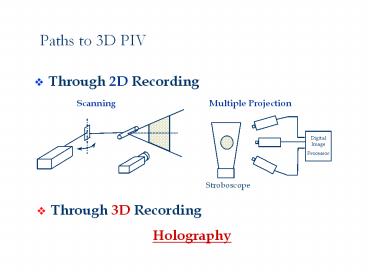Paths to 3D PIV - PowerPoint PPT Presentation
Title:
Paths to 3D PIV
Description:
Paths to 3D PIV Through 2D Recording Multiple Projection Scanning Digital Image Processor Through 3D Recording Stroboscope Holography Principle of HPIV Advantage of ... – PowerPoint PPT presentation
Number of Views:197
Avg rating:3.0/5.0
Title: Paths to 3D PIV
1
Paths to 3D PIV
Holography
2
Principle of HPIV
Displacement Velocity
3
Advantage of holography
- True 3D imaging
- Instantaneous Volumetric
- High Information Capacity(106 - 109 Particles)
- Real-Time Recording but Off-line Data Transfer
Processing
4
How to get true 3D imaging?
- Phase Preservation
- OOexpi(f-wt)
- or OOsin(f-wt)
- How to record f?
- Any light sensitive media records intensity
- IO2 O2
- Need to encode phase f into some intensity
modulation
5
Encoding Phase
-- Use interference of coherent light!
E R O Reference wave Object wave where R
R expi(j-wt) , OOexpi(f-wt) Recorded
Intensity IRO2 R2 O2 2ROsin(f-j)
6
Principle of Holography
O
I RO2 R2 O2 2ROsin(f-j)
R
I (RO)(RO) R2 O2 RORO
O
T R2 O2 RORO
Usually R exp(-iwt) T 1 O2 O O
O
7
Experimental Demonstration
Reference beam, object beam Virtual, real
image Transmission or Reflection Hologram?
Setup Considerations Coherence length vs. path
length difference Exposure energy In the linear
range RO ratio
8
Transmission or Reflection Hologram
Reflection hologram created by 2 plane waves
traveling towards opposite sides (Volume Hologram)
Transmission hologram created by 2 plane waves
traveling towards the same side
9
Reflection Hologram
Bragg Condition 2dsinqml
10
In-line (Gabor) Holography
Traditional for particle fields
- Simple geometry
- Low coherence energy requirement
- Speckle noise
- (limit seeding density seeding depth)
- Large depth of focus
- (practically only 2D vectors)
11
Speckle Noise (in-line hologram)
Ok S ok Sk exp(ifk) Random Walk
Reconstruction field of an in-line hologram for
an ensemble of particles B S ok S ok Type-I
speckle -- interference between B and the
scattered waves ?Major Source of Speckle Type-II
speckle -- self-interference of the scattered
waves.
12
Speckle noise decrease Signal-to-Noise Ratio
40 particles /mm3
6 particles /mm3
1 particle /mm3
13
Off-Axis Holography as Solution
- Off-axis HPIV
- Higher SNR
- Higher Seeding Density
- Complex Geometry
- Higher Coherence Required
14
IROV - In-line Recording Off-axis Viewing
Holography
- IROV Use side scattering
- Suppresses speckle noise
- Reduces image depth of focus
Making In-line based HPIV feasible
Meng Hussain (1995) Appl. Opt. 34, 1827
15
IROV Experimental Setup
Recording
Reconstruction
16
Use of High-Frequency Fringes on In-Line Holograms
Negligible influence of forward scattering Since
OL ltlt R, IL ltlt I sig
17
IROV suppresses speckle noise
Reconstruction field of an in-line hologram for
an ensemble of particles B S ok S ok
- Completely avoids type-I speckle
- greatly reduces type-II speckle
Off-axis Viewing receives only S ok
18
Improved SNR by IROV
In-line Viewed
IROV
19
Reduction of Depth of Focus by IROV
In-line Fraunhofer diffraction
0 degree
20 degree
20
Proof of Principle Experiment
21
IROV Measurement of a Vortex Ring
22
Post Processing
23
IROV Data Processing Genetic Algorithm
Particle Pairing
- Low density requires intelligent pairing
- GA searches large solution space
24
Genetic Algorithm Particle Pairing
25
Why Genetic Algorithm?
Many possibilities to pair particles Need to
numerate and filter
- Conventional searching methods
- Computation intensive
- Difficult to incorporate intelligence
- Time consuming
- Genetic Algorithm
- Efficient in searching large space
- Built-in intelligence to follow fluid dynamics
- Fast and inherent parallel processing speed
26
(No Transcript)
27
Two Approaches of HPIV Developed at LFD
Off-axis HPIV high-end
In-line (IROV) HPIV low-cost
28
Digital In-line Holography
29
Dual-Reference Off-Axis Technique
- High Seeding Density Allowed
- Small Depth of Focus
- Image Separation Removes
- Direction Ambiguity
- Complex Optical Geometry
- High Energy Laser Required
- High Coherence of Beam
- Needed
30
Gemini Off-axis HPIV System
31
Concise Cross Correlation(CCC) Algorithm
- Matching by particle groups
- Uses particle centroids only
- Group shifting for matching
- Decomposition of operation
- Low data volume / high compression rate
- High-speed processing
32
System Test Flow- Excited Air Jet
33
Phase-Locked Vortex
Side View
Top View
34
Vorticity
35
Vorticity Iso-surface
To be re-made
36
HPIV Measurement of Tab Wake
37
Vortab Flow HPIV Measurement Result
- Amount of Data 400,000 Vectors
- Mean Velocity 16.67 cm/sec.
38
Vortab Flow Vorticity Iso-Surfaces
39
Fundamental Challenges
- 3D Signal Decoding
- Complex Flow Mapping
- Large Data Quantity
- User-friendly?
40
Holographic Flow Visualization a Tool for
Studying 3D Coherent Structures and Instabilities
Kansas State University, ISSI, Wright Laboratory,
WP/AFB
41
Off-Axis HFV of Vortex Flame
(c)
(b)
(a)
Holographic Images of Three Vortex-Flame Systems
Photographed from Two Angles (a) or Using Two
Magnifications (b and c).
42
IROV HFV of Turbulent Milk Drop
Holographic Images of A Milk Drop Undergoing Bag
Instability (a, b)
Holographic Images of A Turbulent Milk Drop (a)
and Its Downstream Breakdown (b, c)
43
Naturally, HPIV is an ideal diagnostic tool for
studying particulate phase - 3D and dynamically































